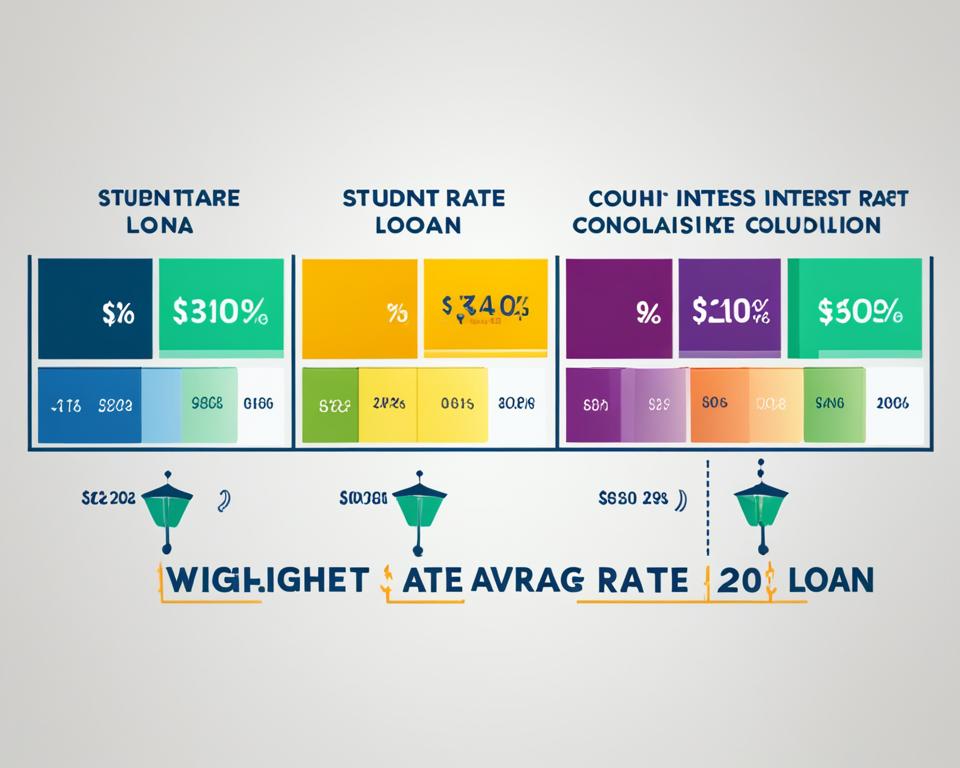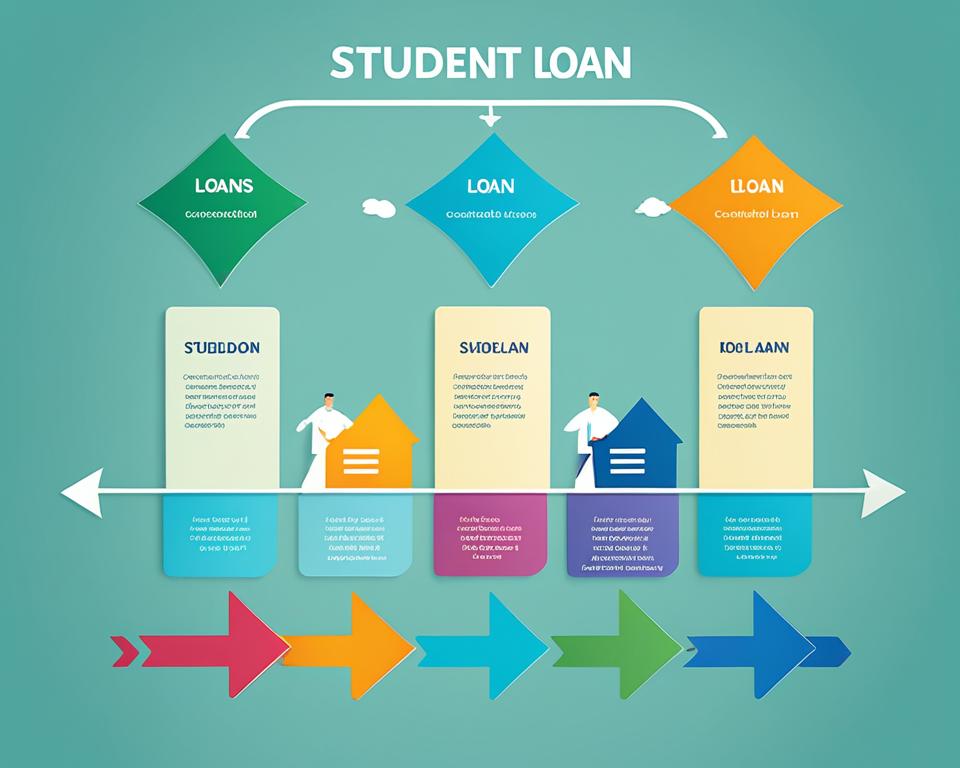In the landscape of American education finance, the student loan consolidation process stands out as a beacon of hope for many borrowers seeking simplification and clarity. Those looking to consolidate federal student loans are often motivated by the desire for a singular, manageable monthly payment and the potential advantages that the consolidation journey promises. Understanding how to consolidate student loans can pave the way for a financial reset, allowing for simpler budgeting and, in some cases, more lenient repayment terms.
However, embarking on this path requires a well-informed approach, as consolidation is an irreversible decision with both benefits and drawbacks. By comprehensively grasping the process and its implications, borrowers can make decisions that align closely with their long-term financial goals and personal circumstances.
Key Takeaways
- Consolidation can merge multiple loans into one for a single monthly payment.
- An understanding of the consolidation process ensures informed financial decisions.
- Assessing the benefits and downsides is crucial as the decision is permanent.
- Extended repayment periods can lower monthly payments but may increase interest.
- Choosing consolidation demands a careful consideration of interest rates and loan types.
- It is imperative to review progress towards any loan forgiveness programs before consolidating.
Understanding the Basics of Student Loan Consolidation
In the journey to achieve financial freedom, understanding student loan consolidation steps and requirements is a pivotal element for borrowers who carry the weight of multiple student loans. The idea behind consolidation is straightforward: simplify your finances by merging various loans into one. But the decision to consolidate should be made with a clear grasp of the process and its implications.
What is Student Loan Consolidation?
Student loan consolidation is a financial strategy that combines multiple student loans—whether they are federal or private—into a single loan with one monthly payment plan. This can help streamline debt management and potentially offer lower monthly payments. However, it’s important to note that while the payments may become more manageable, the lifecycle of the loan could extend, possibly leading to a greater amount of interest paid over time.
Differences Between Federal and Private Loan Consolidation
The differences between federal and private loan consolidation are stark and worth careful consideration. Federal loan consolidation merges your federal loans into one Direct Consolidation Loan, with a fixed interest rate based on the weighted average of the interest rates on your existing loans. Private loan consolidation, sometimes referred to as refinancing, can combine both federal and private loans, but the new interest rate is based on your creditworthiness, which could result in a lower rate.
| Features | Federal Loan Consolidation | Private Loan Consolidation |
|---|---|---|
| Type of Loans Consolidated | Federal loans only | Both federal and private loans |
| Interest Rate | Fixed (weighted average) | Variable or fixed (credit-based) |
| Application Fee | Free | Varies by lender |
| Eligibility for Federal Programs | Preserved (e.g., PSLF, IDR plans) | Typically lost |
How Does Consolidation Affect Your Student Loan Terms?
Consolidating your student loans can affect your loan terms in different ways. For example, student loan consolidation requirements may necessitate that you forego certain borrower benefits associated with your original loans, especially in the case of federal loan consolidation, where benefits such as loan forgiveness and income-driven repayment options are preserved. Always weigh the longer repayment term and potentially higher total interest against the convenience of a single monthly payment.
Is there a specific process for consolidating student loans?
Many borrowers looking to streamline their repayment plans and enjoy the simplicity of a single monthly payment often consider consolidating their student loans. The consolidate student loans process is indeed structured and involves several crucial steps that must be carefully followed to ensure eligibility and to secure a suitable new repayment plan.
To get started, one of the first tasks is to complete a student loan consolidation application, specifically the Direct Consolidation Loan Application, which can be found on the Federal Student Aid website. This application marks the formal request to consolidate one or more of your federal education loans into a single, new loan.
- Analyze current federal student loans for eligibility.
- Review the potential impact on repayment terms and benefits.
- Complete the Direct Consolidation Loan Application Form.
- Select a suitable repayment plan for your consolidated loan.
- Wait for application processing and finalization.
Borrowers should not only assess their current loan details but also analyze the implications of consolidation on their overall financial plan. Particularly, it’s important to consider how consolidation could change your repayment term, monthly payments, and how interest capitalization might affect the total cost of the loan.
| Before Consolidation | After Consolidation |
|---|---|
| Multiple loan servicers and due dates | Single loan servicer and one monthly due date |
| Varying interest rates | One fixed interest rate based on a weighted average |
| Multiple repayment plans | Choice of consolidation-specific repayment plan options |
| Differing loan balances | One combined loan balance |
The process of consolidating student loans is a decision that warrants much thought, particularly around the question – “Is there a specific process for consolidating student loans?” Indeed, it is a process that necessitates a strategic approach, offering a structured roadmap to ease the complexities associated with managing various federal student loans.
In essence, by understanding the student loan consolidation application process and carefully considering personal financial situations, borrowers can make well-informed decisions that align with their long-term financial goals and repayment capabilities.
Evaluating Your Student Loans for Consolidation Eligibility
Discovering the best way to consolidate student loans starts with a thorough review of your current financial landscape. As a borrower contemplating consolidation, you’re tasked with evaluating student loans to determine whether they meet consolidation eligibility. This involves a tactical assessment that looks beyond the surface numbers, piercing into the conditions of each existing loan you hold.

To accurately evaluate the eligibility of your loans for consolidation, consider their characteristics and how they align with your financial objectives. Integrating loans with varying interest rates or those qualifying for forgiveness programs may not always be advantageous. Here’s an insight into some factors that should influence your decision:
- **Interest Rates:** Check if consolidating would lead to a higher weighted interest rate over time, thus costing you more in the long run.
- **Current Benefits:** Loans with benefits like rate discounts, principal rebates, or forgiveness opportunities should be scrutinized before consolidating.
- **Loan Forgiveness Programs Progress:** For participants in programs like PSLF or IDR plans, consolidation may reset your qualifying payment count, delaying potential forgiveness.
Below is a table that can serve as a guideline for comparing the eligibility criteria of your student loans:
| Loan Type | Current Interest Rate | Qualification for Forgiveness Programs | Eligibility for Consolidation |
|---|---|---|---|
| Federal Subsidized | 3.4% | Yes (PSLF, IDR) | Eligible |
| Federal Unsubsidized | 3.86% | Yes (PSLF, IDR) | Eligible |
| Private Loan A | 7.5% | No | Eligible through Refinancing* |
| Private Loan B | 9% | No | Not Recommended |
*Note that private loans can’t be consolidated through federal programs but may be consolidated through private refinancing options.
Undertaking this evaluation is indispensable for mapping out a strategic consolidation plan tailored to your unique financial scenario. Exercising due diligence during this preliminary stage ensures that your consolidation decision positions you for a future of financial wellness.
Navigating the Federal Student Loan Consolidation Application
Embarking on the journey of applying for a Direct Consolidation Loan involves a straightforward yet meticulous process. Borrowers have the option to complete the federal student loan consolidation application online, or if preferred, the traditional way by mailing in the required paperwork. This strategic move can streamline multiple federal student loans into a single monthly payment, potentially easing financial management for graduates.
Steps to Apply for a Direct Consolidation Loan
The first step is to visit the Federal Student Aid’s official website, where the consolidation process begins. Here, one can access the application, review detailed instructions, and gather more information on the consolidation process. It’s critical to follow these steps carefully to ensure that the consolidation will serve the borrower’s financial situation effectively.
Documents Required for Federal Loan Consolidation
The required documents for loan consolidation are the cornerstone of a successful application. Borrowers must prepare to present proof of their graduation status or verification of enrollment part-time or less. Additionally, recent loan statements—detailing current federal student loan balances and statuses—are indispensable. A valid form of identification, such as a driver’s license or passport, is also necessary to confirm one’s identity throughout the process.
- Proof of graduation or current enrollment status
- Most recent loan statements
- Government-issued identification
It is essential for borrowers to provide accurate and thorough information on these documents to prevent any delays or complications. As every borrower’s academic and financial background is unique, the specific requirements may slightly vary. However, ensuring the completeness of these documents will facilitate a smoother application process.
The Pros and Cons of Consolidating Federal Student Loans
When it comes to managing education debt, many borrowers consider the pros and cons of consolidating federal student loans to streamline their finances. Federal loan consolidation can merge multiple student loans into one, potentially simplifying the repayment process. However, this decision carries both federal loan consolidation benefits and potential drawbacks that must be carefully weighed.
Benefits of Federal Loan Consolidation
Federal loan consolidation offers several advantages. It can reduce the hassle of dealing with multiple service providers and due dates, thus decreasing the chances of missed payments. Moreover, consolidating your federal student loans may provide access to various repayment plans that can adjust monthly payments based on your income, making them more manageable. Additionally, those pursuing Public Service Loan Forgiveness may find consolidation a strategic step to qualify for the program.
Potential Drawbacks and Considerations
Despite its advantages, there are potential drawbacks to student loan consolidation that borrowers need to consider. Consolidating loans can sometimes result in a longer repayment period, contributing to more interest paid over the life of the loan. Furthermore, borrowers may also lose certain benefits like interest rate discounts and rebates if they had been previously available on their original loans. It’s also important to note that any progress made towards loan forgiveness could be reset with consolidation.
In summary, while federal loan consolidation can lead to streamlined payments and potential access to different repayment options, it may also extend the repayment period and increase the total interest paid. Borrowers are urged to assess their personal financial situations and the long-term implications before deciding to consolidate their student loans.
Calculating the Weighted Average Interest Rate
When it comes to student loan consolidation, one critical aspect is calculating the weighted average interest rate of your existing loans. This is the method used to determine the student loan consolidation interest rate for your new Direct Consolidation Loan. The interest rate on a Direct Consolidation Loan is a fixed rate, which means it will not change for the duration of the loan. The calculation entails taking the average of the interest rates on the loans being consolidated, weighted by the loan amounts, and then rounding up to the nearest one-eighth of a percent.
To better understand this process, take into consideration that each loan’s interest rate is proportionally factored in based on the total loan value. Therefore, higher-balance loans with higher interest rates will carry more weight in the average. Conversely, smaller loans with lower interest rates will be less influential.
Given the importance of accuracy in this process, it’s recommended to use official tools or consult with a financial advisor to ensure precise calculations. The Direct Consolidation Loan Application conveniently performs this computation automatically, taking some of the burdens off the borrower. However, for those preferring a hands-on approach or looking to estimate their rates before making a decision, various online interest rate calculators are available.
| Loan Amount | Interest Rate | Weighted Interest |
|---|---|---|
| $10,000 | 4.5% | $450 |
| $15,000 | 6.0% | $900 |
| $5,000 | 3.6% | $180 |
| Total | Weighted Average | 5.04% |
It is important to perform calculations or use resources familiar with calculating weighted average interest rates for consolidating federal student loans to ensure financial decisions are made with the most accurate information at hand.

How Consolidating Federal Loans Affects Repayment Plans
Choosing to consolidate federal student loans can have substantial effects on how borrowers manage and repay their debt. One of the most consequential changes that come with consolidation is the modification of available repayment options, particularly for those seeking relief through flexible repayment or forgiveness programs.
Access to Income-Driven Repayment Plans
One of the key considerations when consolidating is the impact on repayment plans. Federal student loan consolidation can offer a pathway to differing income-driven repayment plans (IDR), providing a reduced monthly payment amount for borrowers whose earnings are not enough to cover larger payments. These plans adjust payments according to income and family size, potentially leading to a more manageable financial situation. Importantly, for those not originally qualified for certain types of IDR, consolidating can grant access to these beneficial options.
Impact on Public Service Loan Forgiveness
Consolidation’s influence extends to the realm of loan forgiveness—especially the Public Service Loan Forgiveness (PSLF) program. PSLF serves those working in the public service sector, aiming to forgive the remaining balance on Direct Loans after the borrower has made 120 qualifying monthly payments under a qualifying repayment plan. One crucial aspect for borrowers to note is that if they consolidate loans after making some qualifying payments toward PSLF, their payment count will reset, as consolidation creates a new loan with its own terms. This reset impact on repayment plans can affect the timeline for forgiveness, so it’s imperative for borrowers to plan strategically concerning their work in public service and the best time to consolidate.
With these potential benefits and drawbacks, borrowers are encouraged to carefully consider how federal loan consolidation can alter their trajectory toward repaying their student loans. From gaining access to new IDR plans to understanding the nuances of how consolidation affects PSLF, the informed decision-making process underpins successful financial management in the journey to debt freedom.
Private Student Loan Consolidation Explained
When it comes to managing student debt more effectively, private student loan consolidation emerges as a strategy worth considering. Different from federal loan consolidation, private consolidation or refinancing offers an opportunity to combine both federal and private student loans into one new loan with potentially lower interest rates and changed repayment terms. Understanding the intricacies of consolidation terms and choosing a private lender are vital steps in this financial journey.
Understanding the Terms and Conditions
Before diving into private student loan consolidation, it’s essential to parse through the terms and conditions offered by private lenders. This involves a meticulous review of interest rates, repayment schedules, and borrower benefits. Consolidation terms can significantly affect overall payment amounts and the flexibility of repayment options. Borrowers should be well-aware of the repercussions that refinancing may have on federal student loan benefits, such as income-driven repayment plans and loan forgiveness programs which could be forfeited upon consolidation with a private lender.
Choosing a Private Lender for Loan Consolidation
When looking into choosing a private lender for loan consolidation, it’s critical to conduct thorough research to find a trustworthy and competitive offer. Financial institutions and lenders can vary greatly in the terms they provide, which makes it essential to compare aspects like interest rates, fees, customer service, and the experiences of other borrowers. Since this is a long-term commitment, finding a lender that aligns closely with your financial goals and offers clarity on the terms of your new consolidated loan is of the utmost importance.
Ultimately, private student loan consolidation can pave the way to more straightforward loan management, but it also demands a high degree of financial acumen. Borrowers are encouraged to contemplate the impact on their financial future thoroughly and seek guidance when necessary to ensure a decision that will promote fiscal wellness in the long run.
How to Navigate Consolidation with Federal and Private Loans
When it comes to navigating consolidation, borrowers often find themselves at a crossroads, considering the unique challenges of combining federal and private loans. The key distinction here is that federal loan consolidation programs exclude private loans. Therefore, borrowers seek refinancing options with private lenders to manage their diverse loan portfolio effectively. This decision warrants a smart consolidation strategy that comprehensively evaluates the implications of losing federal loan benefits.

One must understand that federal protections and repayment options are forfeited when private lenders refinance federal student loans. These protections include income-driven repayment plans, potential loan forgiveness options, and forbearance or deferment facilities which can be critical during financial hardships. It’s imperative for borrowers to carefully weigh these factors, as the refinancing of federal loans is irreversible.
- Analyze the terms offered by private lenders against existing federal loan benefits.
- Assess the potential for a lower interest rate and the overall cost savings over the life of the loan.
- Consider lender reputation, customer service, and flexibility in repayment plans.
Crafting a well-informed consolidation strategy can indeed be manageable, but it must be approached with thorough research and a clear understanding of one’s financial goals and risk tolerance. Consolidation does not always result in a lower cost of borrowing, but it can streamline payments and potentially unlock better interest rates, making it a beneficial endeavor for the right candidate.
Exploring Consolidation for Special Loan Types
When dealing with student loan consolidation, one must pay careful attention to how special loan types, particularly Perkins Loans and loans from the Federal Family Education Loan (FFEL) Program, are uniquely impacted. For borrowers considering Perkins Loans consolidation or handling their FFEL Program loans, analyzing the benefits these loans currently offer versus those available after consolidation is an essential part of making an informed decision.
Perkins Loans and How They Are Affected by Consolidation
Perkins Loans are distinctive due to their favorable interest rates and cancellation options, which could potentially be forfeited upon consolidation. In particular, teachers and public service employees may lose access to valuable loan forgiveness benefits, making Perkins Loans consolidation a critical decision to evaluate.
Handling Federal Family Education Loan (FFEL) Program Loans
Moreover, those with loans under the Federal Family Education Loan Program might find themselves forfeiting specific benefits upon consolidation. This includes interest rate reductions that are intrinsic to the FFEL Program, which may no longer be applicable once these loans are consolidated with the Direct Loan Program. The complex implications of consolidating these loans require a thorough understanding to ensure borrowers are making choices that serve their long-term financial interests.
| Loan Type | Benefits Before Consolidation | Impact of Consolidation |
|---|---|---|
| Perkins Loans | Low interest rates, cancellation and forgiveness options for qualifying professions | Potential loss of cancellation options and increased interest rates |
| FFEL Program Loans | Interest rate discounts, borrower rebate incentives | Loss of interest rate reductions and rebate benefits |
Please note that the impact of consolidation on these special loan types can vary based on individual circumstances, so it’s advisable to consult with a financial advisor or loan servicing agent to get the most accurate and personalized information.
Strategies to Save Money During the Loan Consolidation Process
Loan consolidation has proven to be a strategic approach for borrowers looking to manage their student loan debt more effectively. Smart planning and a thoughtful approach can unlock opportunities for saving money on loan consolidation and reducing long-term costs. To maximize these financial benefits, certain key strategies should be considered, such as tackling unpaid interest before consolidation and adopting a continuing payments strategy that supports the goal of reducing lifetime interest.
Tips for Reducing Interest Over the Lifetime of the Loan
- Identify any unpaid interest on existing loans and contribute surplus funds toward reducing this amount before consolidating. This proactive step can prevent the unpaid interest from capitalizing, which otherwise increases the principal amount of your new consolidated loan.
- Explore repayment options offering shorter timelines. Accelerated repayment plans can lead to significant savings on interest, despite higher monthly payments.
- Consider biweekly payments instead of monthly payments, which can result in one extra full payment each year, thus reducing interest and the duration of your loan.
Importance of Continuing Payments During the Consolidation Period
Maintaining your typical loan payments during the consolidation process can be particularly advantageous. This continuity of payments will not just keep you disciplined, but it will also chip away at the principal balance, potentially decreasing the amount of interest that accrues over time.
| Strategy | Impact on Loan Consolidation |
|---|---|
| Pay off unpaid interest | Prevents capitalization and keeps principal lower |
| Opt for a shorter loan term | Increases monthly payments but significantly reduces total interest paid |
| Continue regular payments | Decreases principal balance, leading to reduced interest accumulation |
| Biweekly payments | Results in making one additional full payment annually, reducing the loan term and total interest |
Best Practices for Managing Your Consolidated Loans
After navigating the complexities of consolidating student loans, the journey towards financial stability continues with managing consolidated loans effectively. Optimal management involves formulating a suitable repayment plan and fostering financial discipline that aligns with your post-consolidation lifestyle. A solid game plan and commitment to financial health are instrumental in leveraging the advantages of loan consolidation.
Setting Up a Solid Repayment Plan
To steadfastly tread on the path of debt reduction, establishing a repayment plan that is attuned to your financial situation is mandatory. Crafting a plan that is both realistic and ambitious is key in managing your consolidated loans. The plan should not only consider your monthly income and essential expenses but also take into account your long-term financial goals. Financial experts recommend approaches that either accelerate payment to minimize interest in the long run or provide flexibility to adapt to changing financial circumstances.
Maintaining Good Financial Habits Post-Consolidation
The consolidation of your student loans should be viewed as a fresh start to further instill robust financial habits post-consolidation. Making timely payments is a cornerstone of healthy credit, while strategic budgeting helps to avoid derailing your repayment schedule. An overlooked aspect often is the regular monitoring of your loan progress, providing the borrower with both the motivation of seeing the debt decrease and the opportunity to identify and rectify any missteps quickly. Cultivating these practices ensures that the benefits of consolidation are maximized, setting a steady foundation for long-term financial security.
Best Practices for Managing Your Consolidated Loans
What is Student Loan Consolidation?
Student loan consolidation is the process of combining multiple student loans into a single loan with one monthly payment. This can involve consolidating multiple federal loans into one Direct Consolidation Loan, which retains the federal loan benefits, or consolidating through a private lender, which may include both federal and private loans but could potentially lose some federal loan protections.
What are the Differences Between Federal and Private Loan Consolidation?
Federal loan consolidation is done through the Direct Loan Program and is limited to federal loans only. It provides a fixed interest rate based on a weighted average of the loans being consolidated. Private loan consolidation, also known as refinancing, can combine both federal and private loans under a new private loan, potentially at a lower interest rate, but may come with the loss of federal loan benefits.
How Does Consolidation Affect Your Student Loan Terms?
Consolidating loans may lower your monthly payments by extending the repayment period, but it could increase the total amount of interest paid over the life of the loan. It may also allow you to access different repayment plans or forgiveness programs, although this could mean forgoing benefits associated with your current loans, such as interest rate discounts or rebates.
Is There a Specific Process for Consolidating Student Loans?
Yes, there is a specific process for consolidating student loans. For federal loans, it involves completing a Direct Consolidation Loan Application and selecting a repayment plan. With private loan consolidation, you must apply with a lender, undergo a credit check, and agree on new terms for the loan. Each process requires careful consideration of your current loans, terms, and financial situation.
How Do You Determine the Best Way to Consolidate Student Loans?
The best way to consolidate student loans is based on your individual financial goals, current loan benefits, and eligibility for consolidation. To evaluate, review interest rates, repayment terms, potential for loan forgiveness, and whether you can maintain important borrower benefits. Not all loans are ideal for consolidation, especially if they come with specific advantages that would be lost upon consolidating.
What Steps Must Be Taken to Apply for a Direct Consolidation Loan?
To apply for a Direct Consolidation Loan, you must first check your eligibility. Then, complete the Direct Consolidation Loan Application, which is available online or by paper mail, select a repayment plan, and submit the necessary documents. Finally, continue making payments on your old loans until you confirm the consolidation has completed.
What Documents Are Required for Federal Loan Consolidation?
Documents typically required for federal loan consolidation include proof of graduation or enrollment in less-than-part-time status, statements for each loan you are consolidating, and identification. It’s essential to provide accurate, up-to-date information for a smooth consolidation process.
What Are the Benefits of Federal Loan Consolidation?
The benefits of federal loan consolidation include a single monthly payment, fixed interest rates, extended repayment terms, potential access to more favorable repayment plans, and eligibility for certain loan forgiveness programs.
What Are the Potential Drawbacks and Considerations of Consolidating Federal Student Loans?
The potential drawbacks of consolidating federal student loans include a possible increase in the total interest paid over time, loss of borrower benefits associated with original loans, and the resetting of the clock on qualifying payments toward loan forgiveness programs.
How Do You Calculate the Weighted Average Interest Rate When Consolidating Federal Student Loans?
The weighted average interest rate is calculated by taking the average of the interest rates on the loans being consolidated, weighted by the outstanding balance on each loan. The result is rounded up to the nearest one-eighth of one percent and becomes the fixed interest rate for the new consolidated loan. The calculation can be done automatically during the Direct Consolidation Loan application process, manually, or by using an online calculator.
How Does Access to Income-Driven Repayment Plans Change After Consolidation?
Consolidating your federal loans may provide access to income-driven repayment plans that were not previously available to you. This could result in lower monthly payments based on your income but may extend the length of your loan term.
How Does Consolidating Affect Your Eligibility for Public Service Loan Forgiveness?
If you are working towards Public Service Loan Forgiveness (PSLF), consolidating your federal loans can affect your eligibility. Consolidating loans means you’ll start over with a new loan, and any previous qualifying payments would no longer count towards the PSLF 120 payment requirement. It’s crucial to weigh this factor before deciding to consolidate loans when pursuing PSLF.
What Should You Understand About the Terms and Conditions When Choosing Private Loan Consolidation?
When considering private loan consolidation, you should understand interest rates (fixed or variable), repayment terms, fees, penalties, and borrower benefits. Assess how these terms compare with your existing loans to determine whether consolidating is financially advantageous.
How Do You Choose a Private Lender for Loan Consolidation?
Choose a private lender based on competitive interest rates, repayment terms that align with your financial goals, good customer service, and positive lender reviews. Additionally, confirm the lender’s willingness to work with borrowers facing financial hardship. A good credit score and possibly a co-signer are typically required for the best rates.
What Is the Best Strategy for Combining Federal and Private Loans?
The best strategy for combining federal and private loans is to weigh the potential benefits of a single payment and potentially lower interest rates against the loss of federal protections. You can consolidate federal loans through the Direct Loan Program and refinance private loans, but combining both types requires refinancing through a private lender. Carefully consider the loss of federal benefits like loan forgiveness and income-driven repayment plans.
How Are Perkins Loans Affected by Consolidation?
Perkins Loans may lose unique benefits like loan cancellation for certain types of public service when consolidated. It’s important to consider whether the benefits of consolidating outweigh these unique advantages that would be forfeited.
How Should You Handle Federal Family Education Loan (FFEL) Program Loans When Considering Consolidation?
If you have FFEL Program loans, you may consolidate them to take advantage of income-driven repayment plans or qualify for PSLF. However, you might also lose any borrower benefits, such as interest rate reductions or rebates, associated with the original loans. Examine these factors to determine if consolidating your FFEL Program loans is beneficial for your situation.
What Tips Can Help Reduce Interest Over the Lifetime of the Loan?
To reduce interest costs, consider making payments on any unpaid interest before consolidation to avoid capitalization, choosing the shortest repayment term feasible for your budget, and maintaining payments on your current loans until the consolidation is complete to prevent additional interest from accruing.
Why Is It Important to Continue Payments During the Consolidation Period?
Continuing payments during the consolidation period helps prevent interest from accruing on your current loans, which could increase the total loan balance if this interest capitalizes. It keeps your loan in good standing and can shorten the overall repayment period by reducing the amount of unpaid interest that gets added to your new consolidated loan.
What Are the Key Steps in Setting Up a Solid Repayment Plan?
To set up a solid repayment plan for your consolidated loans, first determine the repayment plan that best suits your financial situation, consider the advantages of income-driven repayment options if applicable, and ensure the monthly payments are manageable within your budget. It’s also important to regularly review your plan to ensure it remains aligned with any changes in your financial circumstances.
How Can You Maintain Good Financial Habits Post-Consolidation?
Maintain good financial habits post-consolidation by adhering to your new repayment schedule, keeping track of your loan balance and interest rates, creating a budget to oversee monthly expenses, and setting up automatic payments to avoid late fees. This discipline will help secure your financial well-being and credit score and ensure that you make the most of the consolidation.





